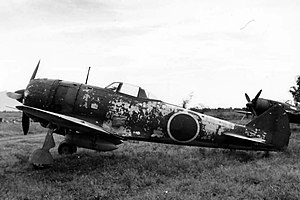| Ki-44 Shoki | |
|---|---|
 | |
| General information | |
| Type | Fighter |
| National origin | Japan |
| Manufacturer | Nakajima Aircraft Company |
| Status | Retired |
| Primary user | Imperial Japanese Army Air Force |
| Number built | 1,225[1] |
| History | |
| Manufactured | 1940–1944 |
| Introduction date | 1942 |
| First flight | August 1940[1] |
| Retired | 1945 |
The Nakajima Ki-44 Shoki (鍾馗, "Devil Queller")[2] was a single-seat fighter-interceptor which was developed by the Nakajima Aircraft Company and operated by the Imperial Japanese Army from 1942 to 1945 during World War II. Its official designation was Army Type 2 Single-Seat Fighter (二式単座戦闘機) and its Allied reporting name was Tojo.
The design and development of the Ki-44 differed greatly from that of other Japanese fighters of the time, incorporating speed and rate-of-climb in preference to maneuverability.[3] This was a result of a need for a heavy fighter aircraft that followed a more offensive doctrine and the Ki-44 is often classified as an Air Defence Fighter.[3][4] Its development ran almost in parallel to its predecessor, the lighter and nimbler Nakajima Ki-43, and yet the two aircraft differed. The Ki-44 had a higher landing speed but was less maneuverable. These were concerns for pilots who would compare it to the Ki-43 or Ki-27 which were far more agile and responsive. As a result, the Ki-44 was first restricted to pilots with at least 1000 hours of flying time due to its tricky handling characteristics. However, it was later found that younger pilots who had not been instilled with the extensive aerobatic training of earlier cadres could manage the aircraft perfectly well, so the restriction was removed.[3]
Nonetheless, the Ki-44 was the fastest climbing Japanese fighter at the time. It was the Imperial Japanese Army's only interceptor type when the USAAF's B-29 Superfortresses began bombing the Japanese mainland in June 1944.[3][5] While there were performance restrictions at high altitude, it was superior to the Ki-43 in that it was capable of matching Allied aircraft in climbs and dives, giving pilots more flexibility in combat and greater pilot confidence than the Ki-43; the basic armament of four 12.7mm machine guns or two 12.7mm guns and two 20 mm cannons (or, in a few aircraft, two Ho-301 40mm cannons of limited range) was far more powerful than the older Ki-43's two 12.7mm machine guns.[6][7]
Production of the Ki-44 was terminated in late 1944 in favour of the more advanced Nakajima Ki-84, and when the war ended, only three sentai units were still equipped with them.[8]
No examples survive today.
- ^ a b Francillon, 1979, p. 223
- ^ Aircraft of the World: The Complete Guide. United States: International Masters Publishers. 1996. p. 32. ISBN 978-1886614161.
- ^ a b c d Millman, 2011, pp.1–8
- ^ Bueschel, 1971
- ^ Aircraft of the World: The Complete Guide. United States: International Masters Publishers. 1996. p. 32. ISBN 1886614164.
- ^ Ethell 1995, p. 101.
- ^ Ethell 1995, p. 100.
- ^ Francillon, 1979, p.221